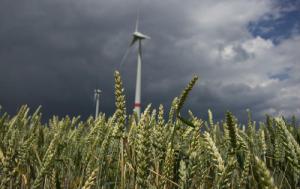Off-grid German Village Banks on Wind, Sun, Pig Manure
By Frank Zeller
Feldheim (Germany) (AFP) – If Germany has taken a pioneering though risky role in shifting to renewable energy, then the tiny village of Feldheim — population 150 — is at its vanguard.
The hamlet near Berlin is Germany’s first to have left the national grid and switched to 100 percent local, alternative energy, swearing off fossil fuels and nuclear power decades before the rest of the country plans to near the same goal.
Electricity now comes from a wind park towering over its gently rolling fields and reaches homes through Feldheim’s own mini smart grid.

More than 99 percent of the wind power is sold into the national system, along with electricity from a solar park on a former Soviet military base.
As winter nears, people here will heat their homes from a biogas plant powered by local pig and cattle manure and shredded corn, while on the coldest days a woodchip plant will also burn forestry waste.
The villagers took bank loans and state subsidies to build the system, in partnership with green power company Energiequelle, but say it is paying off as electricity and heating bills have been slashed.
Feldheim no longer pays for 160,000 litres (40,000 gallons) of heating oil a year, said Werner Frohwitter of the local energy cooperative.
“This money is no longer going to Arab sheiks or (Russian President) Vladimir Putin,” he said at the village 80 kilometres (50 miles) southwest of Berlin. “This money is now staying right here.”
– Green vision, risky gamble –
Depending on who you listen to, Germany’s “Energiewende” or energy shift is a bright green vision for a zero-carbon future or a reckless gamble that will drive Europe’s biggest economy against the wall.
It is certainly Germany’s biggest infrastructure project since World War II and its greatest national challenge since reunification 25 years ago.
